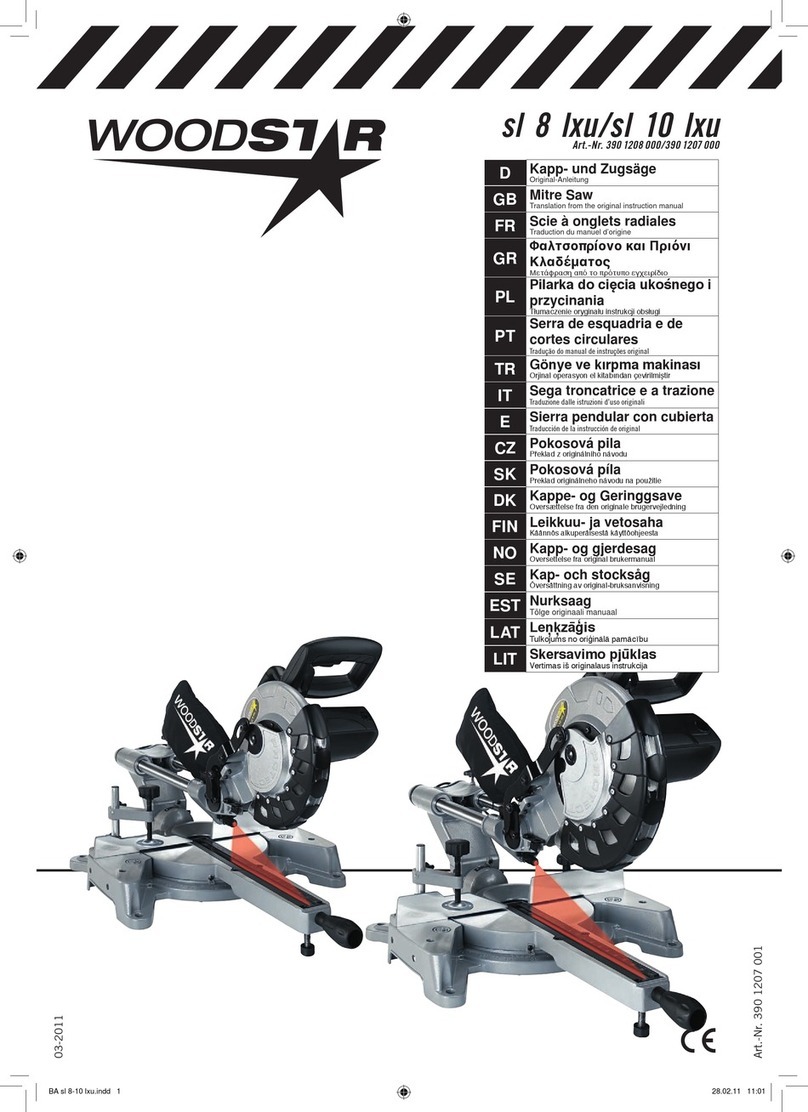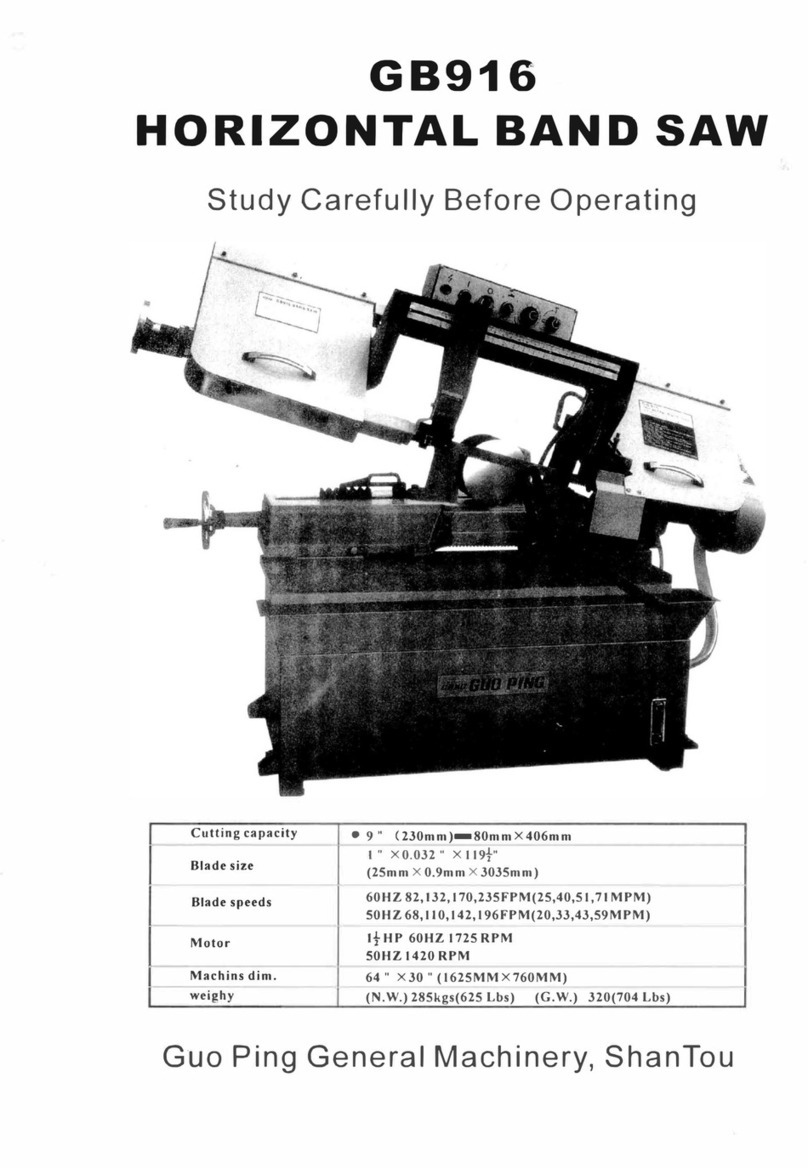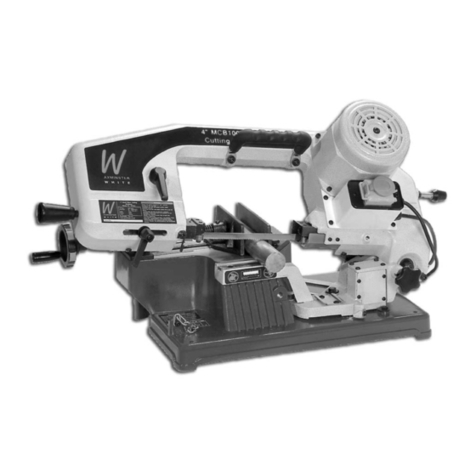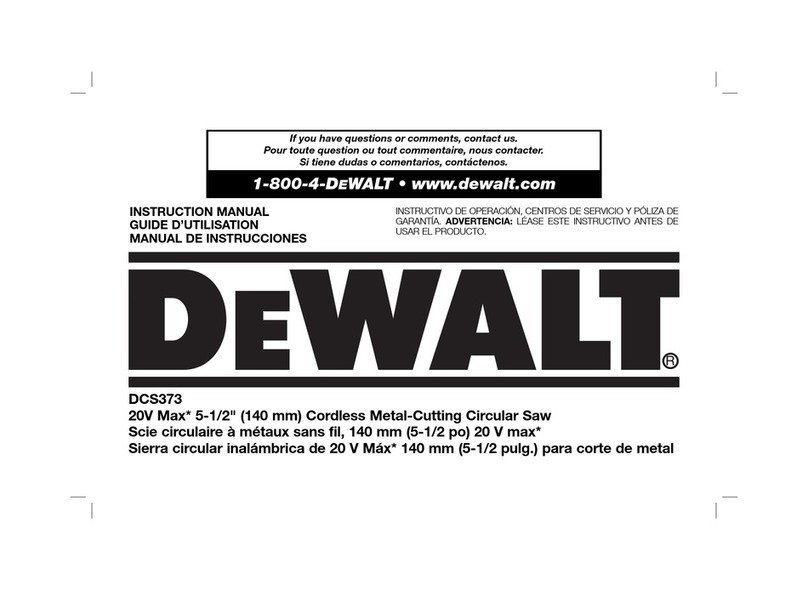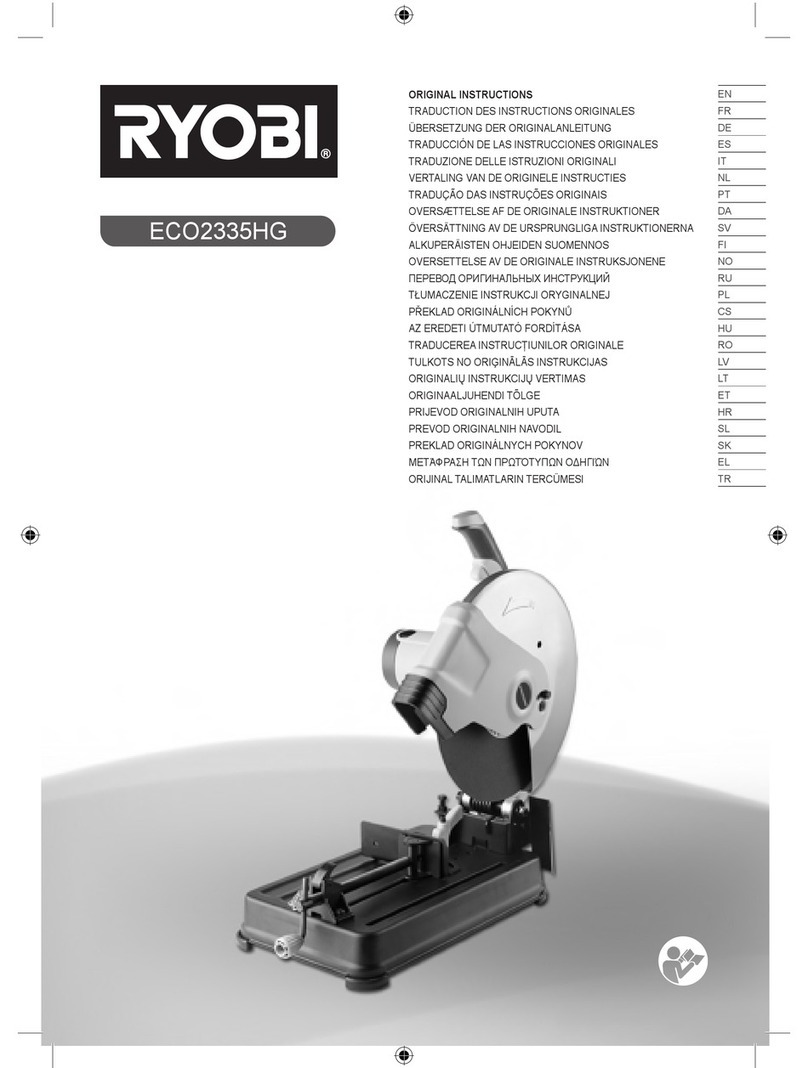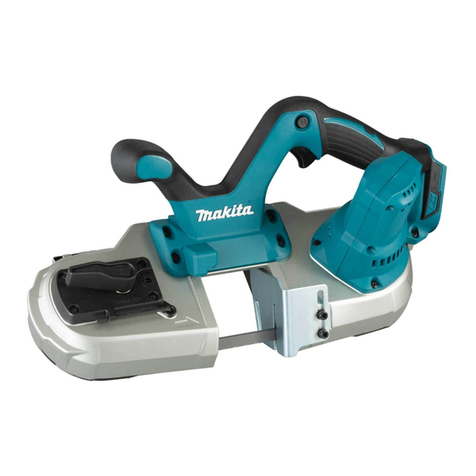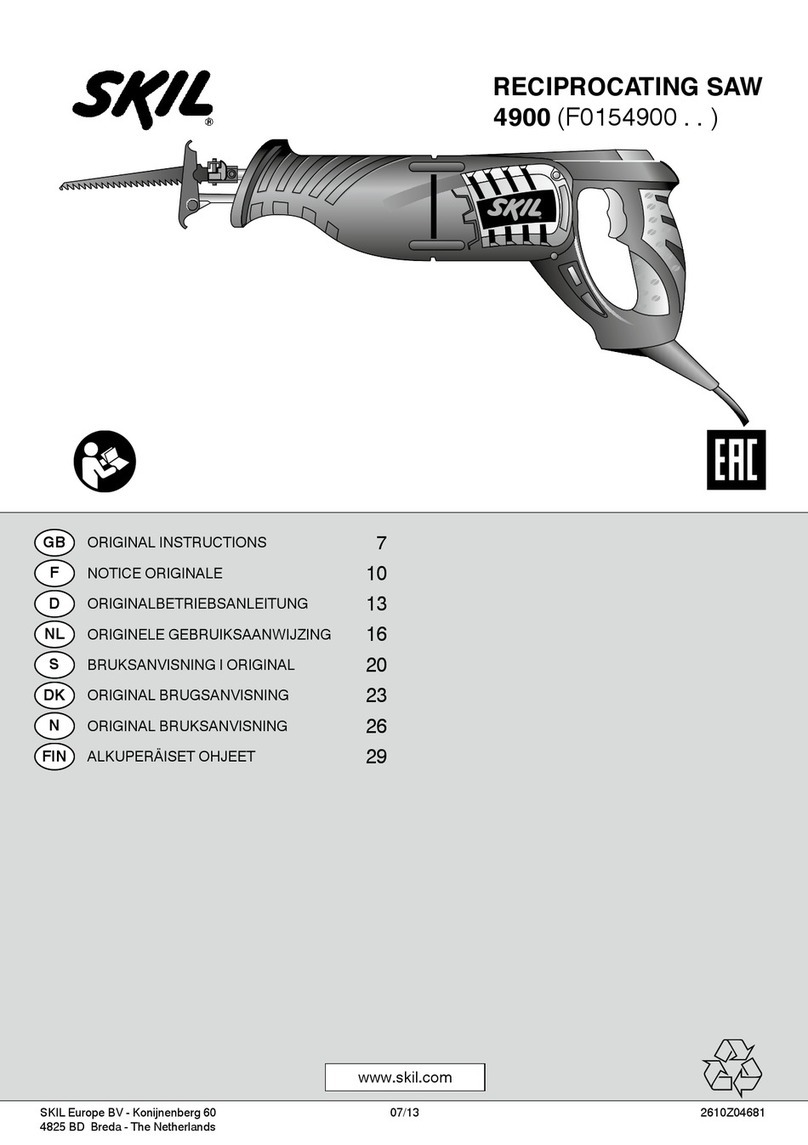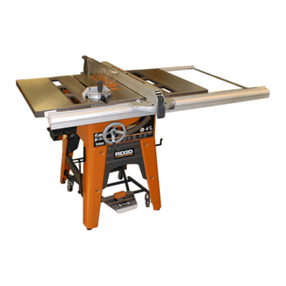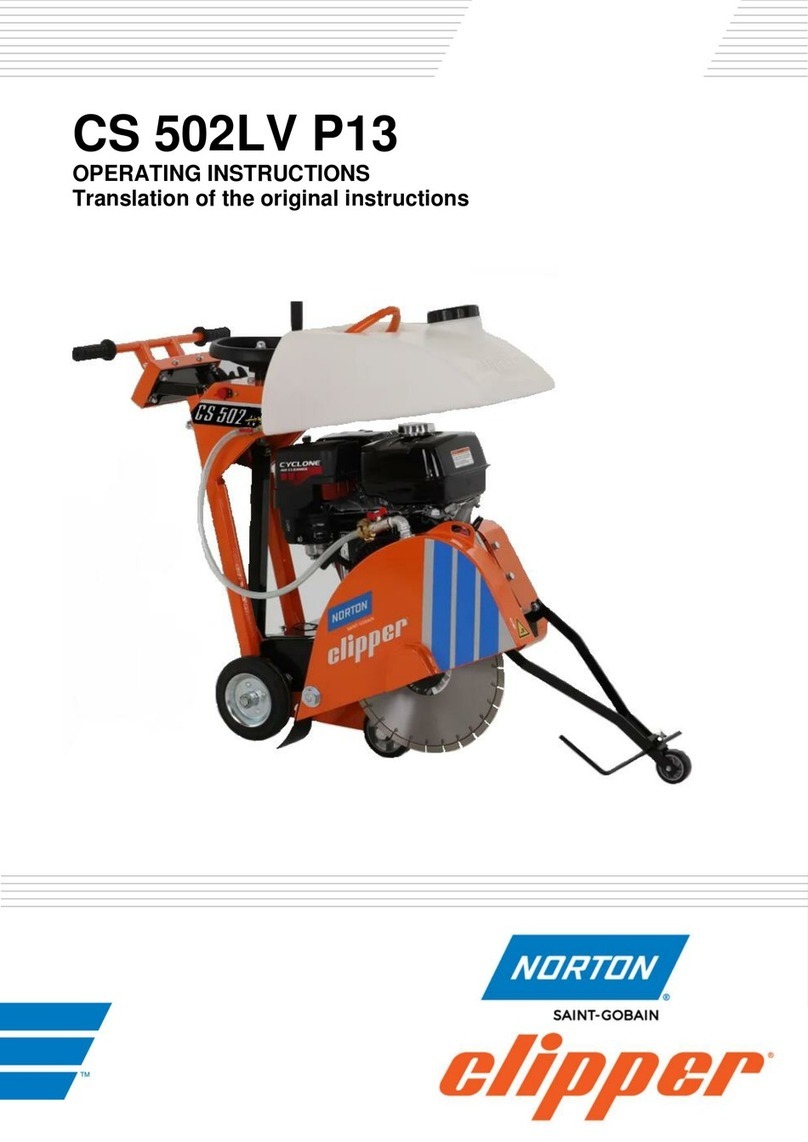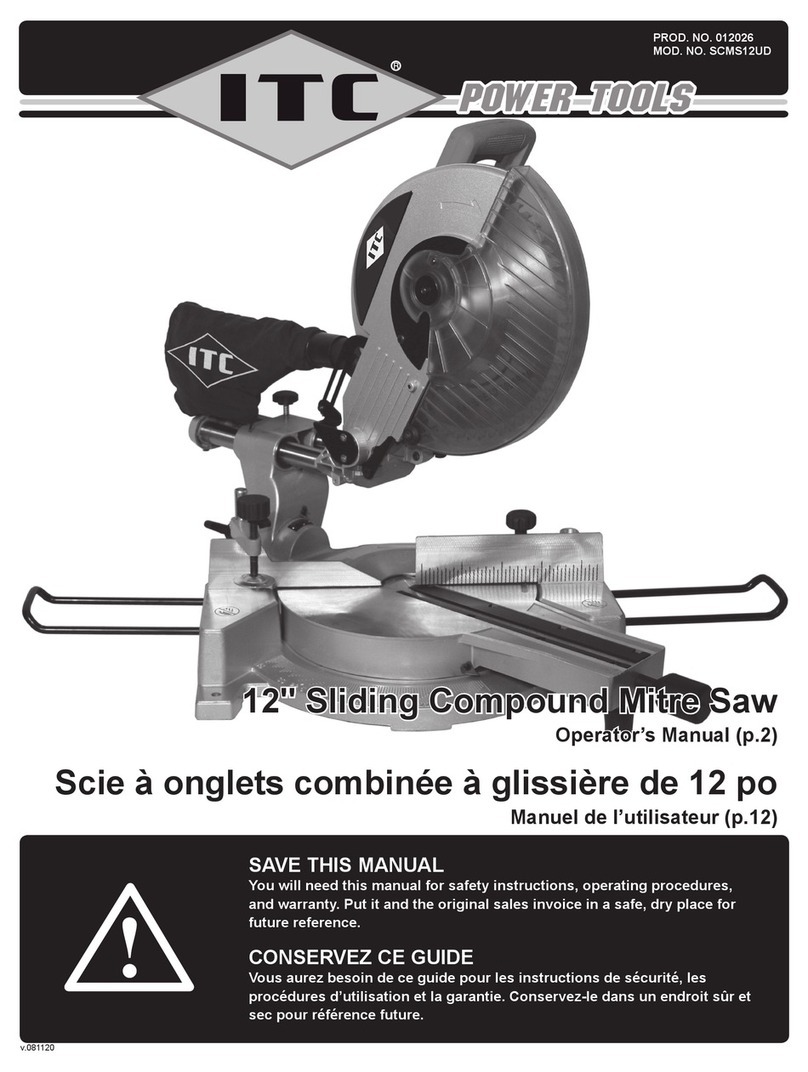PATTA ACS11-185 User manual

Circular Saw
ACS11-185
OPERATION INSTRUCTIONS
Read through carefully and understand these instructions
before use.

-1-
General Power Tool Safety Warnings
(For All Power Tools)
WARNING! Read and understand all instructions. Failure to follow all
instructions listed below may result in electric shock, fire and/or serious
personal injury.
Save all warnings and instructions for future reference.
The term “power tool” in the warnings refers to your mains-operated (corded) power tool or
battery-operated (cordless) power tool.
Work Area Safety
1. Keep work area clean and well lit. Cluttered or dark areas invite accidents.
2. Do not operate power tools in explosive atmospheres, such as in the presence of
flammable liquids, gases, or dust. Power tools create sparks which may ignite the dust
or fumes.
3. Keep children and bystanders away while operating a power tool. Distractions can
cause you to lose control.
Electrical Safety
4. Power tool plugs must match the outlet. Never modify the plug in anyway. Do not use
any adapter plugs with earthed (grounded) power tools.Unmodified plugs and matching
outlets will reduce risk of electric shock.
5. Avoid body contact with earthed or grounded surfaces, such as pipes, radiators, ranges
and refrigerators. There is an increased risk o electric shock if your body is earthed or
grounded.
6. Do not expose power tools to rain or wet conditions. Water entering a power tool will
increase the risk of electric shock.
7. Do not abuse the cord. Never use the cord for carrying, pulling or unplugging the power
tool. Keep cord away from heat, oil, sharp edges or moving parts. Damaged or

-2-
entangled cords increase the risk of electric shock.
8. When operating a power tool outdoors, use an extension cord suitable for outdoor use. Use of a
cord suitable for outdoor use reduces the risk of electric shock.
9. If operating a power in a damp location is unavoidable, use a residual current device
(RCD) protected supply. Use of an RCD reduces the risk of electric shock.
NOTE: The term “residual current device (RCD)” may be replaced by the term “ground fault
circuit interrupter (GFCI)” or “earth leakage circuit breaker (ELCB)”.
Personal Safety
10. Stay alert, watch what you are doing and use common sense when operating a power
tool. Do not use a power tool while you are tired or under the influence of drugs, alcohol,
or medication. A moment of inattention while operating power tools may result in
serious personal injury.
11. Use personal protective equipment. Always wear eye protection. Protective equipment
such as dust mask, non-skid safety shoes, hard hat, or hearing protection used for
appropriate conditions will reduce personal injuries.
12. Prevent unintentional starting. Ensure the switch is in the off-position before
connecting to power source and /or battery pack, picking up or carrying the tool.
Carrying power tools with your finger on the switch or energising power tools that have
the switch on invites accidents.
13. Remove any adjusting key or wrench before turning the tool on. A wrench or a key left
attached to a rotating part of the power tool may result in personal injury.
14. Do not overreach. Keep proper footing and balance at all times. This enables better
control of the power tool in unexpected situations.
15. Dress properly. Do not wear loose clothing or jewellery. Keep your hair, clothing, and
gloves away from moving parts. Loose clothes, jewellery or long hair can be caught in
moving parts.
16. If devices are provided for the connection of dust extraction and collection facilities,
ensure these are connected and properly used. Use of dust collection can reduce
dust-related hazards.

-3-
Power Tool Use and Care
17. Do not force the power tool. Use the correct power tool for your application. The
correct power tool will do the job better and safer at the rate for which it was designed.
18. Do not use tool if switch does not turn it on or off. Any power tool that cannot be
controlled with the switch is dangerous and must be repaired.
19. Disconnect the plug from the power source and/or the battery pack from the power
tool before making any adjustments, changing accessories, or storing power tools.
Such preventive safety measures reduce the risk of starting the power tool accidentally.
20. Store idle power tools out of the reach of children and do not allow persons unfamiliar
with the power tool or these instructions to operate the power tool. Power tools are
dangerous in the hands of untrained users.
21. Maintain power tools. Check for misalignment or binding of moving parts, breakage of
parts and any other condition that may affect the power tool’s operation. If damaged,
have the power tool repaired before use. Many accidents are caused by poorly
maintained power tools.
22. Keep cutting tools sharp and clean. Properly maintained cutting tools with sharp
cutting edges are less likely to bind and are easier to control.
23. Use the power tool, accessories and tool bits etc. in accordance with these
instructions, taking into account the working conditions and the work to be performed.
Use of the power tool for operations different from those intended could result in a
hazardous situation.
Service
24. Have your power tool serviced by a qualified repair person using only identical
replacement parts. This will ensure that the safety of the power tool is maintained.

-4-
VOLTAGE WARNING:
Before connecting the machine to a power source (receptacle, outlet, etc.), be sure the
voltage supplied is the same as that specified on the nameplate of the machine. A power
source with voltage greater than that specified for the machine can result in SERIOUS INJURY
to the user, as well as damage to the machine. If in doubt, DO NOT PLUG IN THE MACHINE.
Using a power source with voltage less than nameplate rating is harmful to the motor.
SPECIFICATIONS
Rated Power Input 1100 W
No-Load Speed 5600 r/min
Max. Cutting Depth 64 mm
Max. Cutting Angle 45°
Blade Size 185 mm×20(19) mm
Net Weight 3.6 kg
※Due to the continuing program of research and development, the specifications herein
are subject to change without prior notice.

-5-
Additional Safety Rules
DANGER:
1. Keep hands away from cutting area and blade. Keep your second hand on auxiliary
handle, or motor housing. If both hands are holding the saw, they cannot be cut by the
blade.
2. Keep your body positioned to either side of the saw blade, but not in line with the saw
blade. KICKBACK could cause the saw to jump backwards.
3. Do not reach underneath the work. The guard can not protect you from the blade below
the work. Do not attempt to remove cut material when blade is moving.
CAUTION: Blades coast after turn off. Wait until blade stops before grasping cut material.
4. Adjust the cutting depth to the thickness of the workpiece. Less than a full tooth of the
blade teeth should be visible below the workpiece.
5. NEVER hold piece being cut in your hands or across your leg. It is important to support
the work properly to minimize body exposure, blade binding, or loss of control.
6. Hold tool by insulated gripping surfaces when performing an operation where the cutting
tool may contact hidden wiring or its own cord. Contact with a “live” wire will also make
exposed metal parts of the tool “live” and shock the operator.
7. Check lower guard for proper closing before each use. Do not operate saw if lower guard
does not move freely and close instantly. Never clamp or tie the lower guard into the
open position. If saw is accidentally dropped, lower guard may be bent. Raise the lower
guard with the Retracting Lever and make sure it moves freely and does not touch the
blade or any other part, in all angles and depths of cut.
To check lower guard, open lower guard by hand, then release and watch guard closure.
Also check to see that Retracting Lever does not touch tool housing. Leaving blade
exposed is VERY DANGEROUS and can lead to serious personal injury.
8. Check the operation and condition of the lower guard spring. If the guard and the spring
are not operating properly, they must be serviced before use. Lower guard may operate
sluggishly due to damaged parts, gummy deposits, or a buildup of debris.
9. Lower guard should be retracted manually only for special cuts such as “Plunge Cuts”
and “Compound Cuts”. Raise lower guard by Retracting Lever. As soon as blade enters the

-6-
material, lower guard must be released. For all other sawing, the lower guard should
operate automatically.
10. Always observe that the lower guard is covering the blade before placing saw down on
bench or floor. An unprotected, coasting blade will cause the saw to walk backwards,
cutting whatever is in its path. Be aware of the time it takes for the blade to stop after
switch is released.
11. When ripping always use a rip fence or straight edge guide. This improves the accuracy
of cut and reduces the chance for blade binding.
12. Always use blades with correct size and shape (diamond versus round) arbor holes.
Blades that do not match the mounting hardware of the saw will run eccentrically,
causing loss of control.
13. Never use saw blades made of high-speed steel.
14. Never use damaged or incorrect blade washers or bolts. The blade washers and bolt
were specially designed for your saw, for optimum performance and safety of operation.
15. Causes and Operator Prevention of Kickback:
—Kickback is a sudden reaction to a pinched, bound or misaligned saw blade, causing
an uncontrolled saw to lift up and out of the workpiece toward the operator;
—When the blade is pinched or bound tightly by the kerf closing down, the blade stalls
and the motor reaction drives the unit rapidly back toward the operator;
—If the blade becomes twisted or misaligned in the cut, the teeth at the back edge of
the blade can dig into the top surface of the wood causing the blade to climb out of
the kerf and jump back toward operator.
Kickback is the result of tool misuse and/or incorrect operating procedures or
conditions and can be avoided by taking proper precautions as given below:
Maintain a firm grip with both hands on the saw and position your body and arm to
allow you to resist KICKBACK forces. KICKBACK forces can be controlled by the
operator, if proper precautions are taken.
When blade is binding, or when interrupting a cut for any reason, release the trigger
and hold the saw motionless in the material until the blade comes to a complete stop.
Never attempt to remove the saw from the work or pull the saw backward while the
blade is in motion or KICKBACK may occur. Investigate and take corrective actions to
eliminate the cause of blade binding.

-7-
When restarting a saw in the workpiece,
center the saw blade in the kerf and
check that saw teeth are not engaged
into the material. If saw blade is binding,
it may walk up or KICKBACK from the
workpiece as the saw is restarted.
Support large panels to minimize the risk
of blade pinching and KICKBACK. Large
panels tend to sag under their own
weight. Supports must be placed under
the panel on both sides, near the line of
cut and near the edge of the panel.
(Fig. 1)
To minimize the risk of blade pinching
and kickback, when cutting operation requires the resting of the saw on the
workpiece, the saw should be rested on the larger portion and the smaller piece cut
off. (Fig. 1&2)
Do not use dull, deformed, cracked or damaged blade. Unsharpened or improperly set
blades produce narrow kerf causing excessive friction, blade binding and KICKBACK.
Keep blade sharp and clean. Gum and wood pitch hardened on blades slows saw and
increases potential for kickback. Keep blade clean by first removing it from tool, and
then cleaning it with gum and pitch remover, hot water or kerosene. Never use
gasoline.
Blade depth and bevel adjusting locking levers must be tight and secure before making
cut. If blade adjustment shifts while cutting, it may cause binding and KICKBACK.
Use extra caution when making a “Plunge Cut” into existing walls or other blind areas.
The protruding blade may cut objects
that can cause KICKBACK. For plunge cuts,
retract lower guard using Retracting
Lever.
ALWAYS hold the tool firmly with both
hands. NEVER place your hand or fingers

-8-
behind the saw. If kickback occurs, the saw could easily jump backwards over your
hand, leading to serious personal injury. (Fig. 3)
Never force the saw. Forcing the saw can cause uneven cuts, loss of accuracy, and
possible kickback. Push the saw forward at a speed so that the blade cuts without
slowing.
16. Use the appropriate riving knife for the blade being used. For the riving knife to work, it
must be thicker than the body of the blade but thinner than the tooth set of the blade.
17. Adjust the riving knife as described in this instruction manual. Incorrect spacing,
positioning and alignment can make the riving knife ineffective in preventing kickback.
18. Always use the riving knife except when plunge cutting. Riving knife must be replaced
after plunge cutting. Riving knife causes interference during plunge cutting and can
create kickback.
19. For the riving knife to work, it must be engaged in the workpiece. The riving knife is
ineffective in preventing kickback during short cuts.
20. Do not operate the saw if riving knife is bent. Even a light interference can slow the
closing rate of a guard.
21. Use extra caution when cutting damp wood, pressure treated lumber or wood containing
knots. Adjust speed of cut to maintain smooth advancement of tool without decrease in
blade speed.
22. Adjustments. Before cutting be sure depth and bevel adjustments are tight.
23. Avoid Cutting Nails. Inspect for and remove all nails from lumber before cutting.
24. When operating the saw, keep the cord away from the cutting area and position it so
that it will not be caught on the workpiece during the cutting operation. The tool is
provided with a front grip and rear handle for two hand operation. Operate with proper
hand support, proper workpiece support, and supply cord routing away from the work
area.
WARNING: It is important to support the
workpiece properly and to hold the saw
firmly to prevent loss of control which could
cause personal injury. Fig. 4 illustrates typical
hand support of the saw.
25. Place the wider portion of the saw base on

-9-
that part of the workpiece which is solidly
supported, not on the section that will fall off
when the cut is made.
As examples, Fig. 5 illustrates the RIGHT way
to cut off the end of a board, and Fig. 6 the
WRONG way.
If the workpiece is short or small, clamp it
down. DO NOT TRY TO HOLD SHORT PIECES BY
HAND!
26. Never attempt to saw with the circular saw
held upside down in a vise. This is extremely
dangerous and can lead to serious accidents.
(Fig. 7)
27. WARNING:Blade coasts to stop after switch
is released. Contact with coasting blade can
cause serious injury. Before setting the tool
down after completing a cut, be sure that the
lower (telescoping) guard has closed and the
blade has come to a complete stop.
28. Do not stop the blades by lateral pressure on
the saw blade.
29. Always use blades recommended in this manual. Do not use any abrasive or grinding
wheels.
30. Wear a dust mask and hearing protection when use the tool.
31. Some material contains chemicals which may be toxic. Take caution to prevent dust
inhalation and skin contact. Follow material supplier safety data.
SAVE THESE INSTRUCTIONS.
WARNING! MISUSE or failure to follow the safety rules stated in this instruction manual
may cause serious personal injury.

-10-
Instructions For Operation
Installing auxiliary handle
CAUTION:
Always be sure that the tool is switched off and unplugged before adjusting or checking
function on the tool.
The screws must be tightened to avoid dangerous loose in the process of using the
machine
Align the hole of the handle connecting plate
with the hole on the back of the upper guard
complete, and fasten the handle connecting
plate to the upper guard complete with screws,
tighten the screws clockwise, then fasten the
auxiliary handle in the hole of the handle
connecting plate.(Fig.8)
1. Upper Guard Complete 3. screw
2. handle connecting plate. 4. auxiliary handle
Adjusting Depth of Cut
CAUTION:
Use a shallow depth of cut when cutting thin
workpiece for cleaner, safer cuts.
After adjusting the depth of cut, always
tighten the lever securely.
Hold the handle with one hand and loosen the
lever on the depth guide with the other. Move
the base up or down. At a desired depth of cut, secure the base by tightening the lever. (Fig. 9)

-11-
Bevel Cutting
Loosen the wing nut on the bevel gauge in front,
and tilt the tool to the desired angle for bevel cut
(0-45°). Secure the wing nut on the bevel gauge
tightly after making the adjustment. (Fig. 10)
Sighting
For straight cuts, align the right notch on the
front of the base with the cutting line on the
workpiece. For 45° bevel cuts, align the left
notch with it. (Fig. 11)
Switch Action
CAUTION:
Before plugging in the tool, always check to see
that the switch trigger actuates properly and
returns to the “OFF” position when released.
To prevent the switch trigger from being
accidentally pulled, a lock-off button is provided
as a safety feature.
To start the tool, push in the lock-off button and
pull the switch trigger. Release the switch trigger to stop. (Fig. 12)
Removing or Installing Saw Blade
CAUTION:
Always be sure that the tool is switched off and unplugged before installing or removing
the saw blade.
Do not use saw blades which do not comply with the characteristics specified in these
instructions.
Be sure the blade is installed with teeth pointing forward in the same direction as the tool
rotation (the arrow on the blade should point in the same direction as the arrow on the
tool).

-12-
The inner flange is supplied for 2 types of saw blades with the inner diameters of 20 mm
and 19 mm. A number “20” is marked on the side with inner diameter of 20 mm, be sure to
choose the correct side of the inner flange for installation according to the diameter of the
blade. Improper installation may result in dangerous vibration and cause serious personal
injury.
Never depress the shaft lock while the saw is running.
Use only original wrench to remove or install the blade.
The following blade can be used with this tool:
Max. Dia. Min. Dia. Inner Dia. Blade Thickness Kerf
185 mm 170 mm 20 (19) mm 1.7 mm 1.9 mm

-13-
To remove the blade, press the shaft lock so that
the blade cannot revolve and use the hex wrench
to loosen the hex socket head bolt
counterclockwise., (Fig. 13)
Then remove the hex socket head bolt, outer
flange, raise the lower safety guard as much as
possible, and remove the saw blade. (Fig. 14)
To install the saw blade, follow the removal
procedures in reverse. Install the inner flange,
saw blade, outer flange and hex socket head bolt,
in that order. (Fig. 15)
Be sure to secure the hex socket head bolt
clockwise tightly with the shaft lock fully
depressed.
When changing blade, make sure to also clean upper and lower blade guards of accumulated
sawdust. Such efforts do not, however, replace the need to check lower guard operation
before each use.

-14-
Cutting Operation
CAUTION:
Be sure to move the tool forward in a straight line gently. Forcing or twisting the tool will
result in overheating the motor and dangerous kickback, possibly causing severe injury.
Do not stop the saw blade by lateral pressure on the disc.
The operator should avoid standing or exposure to the position of the circular saw cutting
debris and sawdust
Using goggles helps to avoid injuries.
Hold the tool firmly. The tool is provided with both a front grip and rear handle. Use both to
best grasp the tool. If both hands are holding saw, they cannot be cut by the blade.
Set the base on the workpiece to be cut without
the blade making any contact. Then turn the tool
on and wait until the blade attains full speed.
Now simply move the tool forward over the
workpiece surface, keeping it flat and advancing
smoothly until the sawing is completed. (Fig. 16)
To get clean cuts, keep your sawing line straight
and your speed of advance uniform. If the cut fails to properly follow your intended cut line,
do not attempt to turn or force the tool back to the cut line. Doing so may bind the blade and
lead to dangerous kickback and possible serious injury. Release switch, wait for blade to stop
and then withdraw tool. Realign tool on new cut line, and start cut again.
Attempt to avoid positioning which exposes operator to chips and wood dust being ejected
from saw. Use eye protection to help avoid injury.
Rip Fence (Guide Rule)
The handy rip fence allows you to do
extra-accurate straight cuts. Simply slide the rip
fence up snugly against the side of the
workpiece and secure it in position with the wing
bolt on the front of the base. It also makes
repeated cuts of uniform width possible. (Fig. 17)

-15-
Maintenance And Inspection
CAUTION:
Always be sure that the tool is switched off and unplugged before attempting to perform
inspection or maintenance.
Maintenance of the motor
The motor unit winding is the very “heart” of the power tool. Exercise due care to ensure the
winding does not become damaged and /or wet with oil or water.
Inspecting the carbon brushes
Remove and check the carbon brushes regularly.
Replace when they wear down to the limit mark
(Fig. 18). Keep the carbon brushes clean and free
to slip in the holders. Both carbon brushes should
be replaced at the same time. Use only identical
carbon brushes.
Use a screwdriver to remove the brush holder
caps. Take out the worn carbon brushes, insert
the new ones and secure the brush holder caps.
(Fig. 19)
※Damaged cord must be replaced by a special cord purchased from authorized service
center.
※To maintain product SAFETY and RELIABILITY, repairs, any other maintenance or
adjustment should be performed by authorized service centers, always using original
replacement parts.

-16-

-17-
EXPLANATION OF GENERAL VIEW
1 Hex Socket Head Bolt M6×20 22 Spring Washer 6
2 Outer Flange 23 Wing Nut M6
3 Inner Flange 24 Screw M6×17
4 Bearing Holder 25 Rubber Sleeve
5 Drive Spindle 26 Upper Guard Complete
6 Ball Bearing 6201DDU 27 Rubber Pin(4×6.8)
7 Spacer Ring 12×18×6 28 Ball Bearing 6000VV
8 Circlip for Shaft 38 29 Lock Lever
9 Lower Safety Guard 30 Backward Spring(6.3×0.6×38)
10 Pan Head Screw M4×12 31 Armature Assembly
11 Adjusting Plate 32 Insulation Washer
12 Wheel 33 Ball Bearing 608ZZ
13
Split Spring-type Clevis Pin With
Head
34 Bearing Cover
(22×24×10.5)
14 Extension Spring 35 Rubber Washer
15
Cross Recessed
Countersunk Head Screw
M5×16
36 Pan Head Tapping Screw (ST4.8×56)
16 Bearing Retianer 37 Baffle Plate
17 Gear 38 Stator Assembly
18 Ball Bearing 606ZZ 39 Handle Cover
19 Pan Head ScrewM4×12 40 Pan Head Tapping Screw (ST4.2×17)
20 Guard Cover 41 Strain Relief
21 Flat Washer(6.5×13×1)42 Cord

-18-
EXPLANATION OF GENERAL VIEW
43 Cord Guard 58 Flat Washer(6.5×13×1)
44 Capacitor 59 Spring Washer 6
45 Switch 60 Wing Bolt M6×20
46 Motor Housing 861 Rip Fence
47 Pan Head Tapping
Screw
(ST4.2×20)
862 Auxiliary Handle
48 Pan Head Screw M5×40
(with
Flat Washer)
863 Hex Socket Head Screw M6×16(with
Spring and Flat Washer)
49 Nameplate 864 Handle Connecting Plate
50 Carbon Brush Holder 865 Hex Wrench 5
51 Carbon Brush
52 Brush Holder Cap
53
Round Head Square Neck Bolt
M6×30
54 Base Assembly
55 Stretch Pin(6×35)
56 Wing Bolt M6×20
57
Compression Spring
(
8.3×1×13.5
)

-19-
Table of contents
